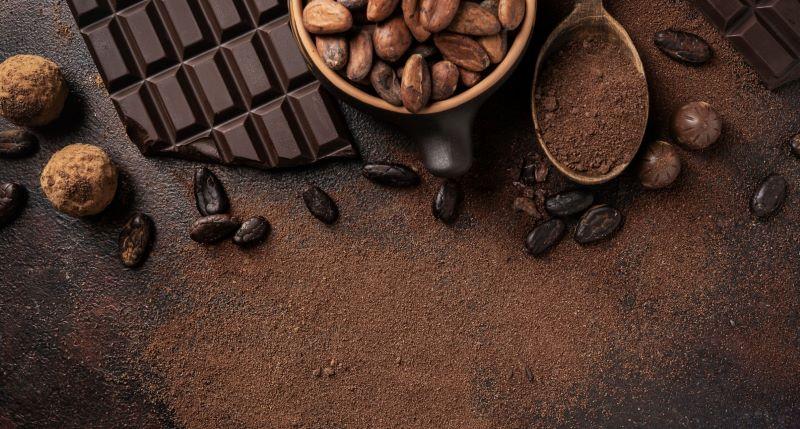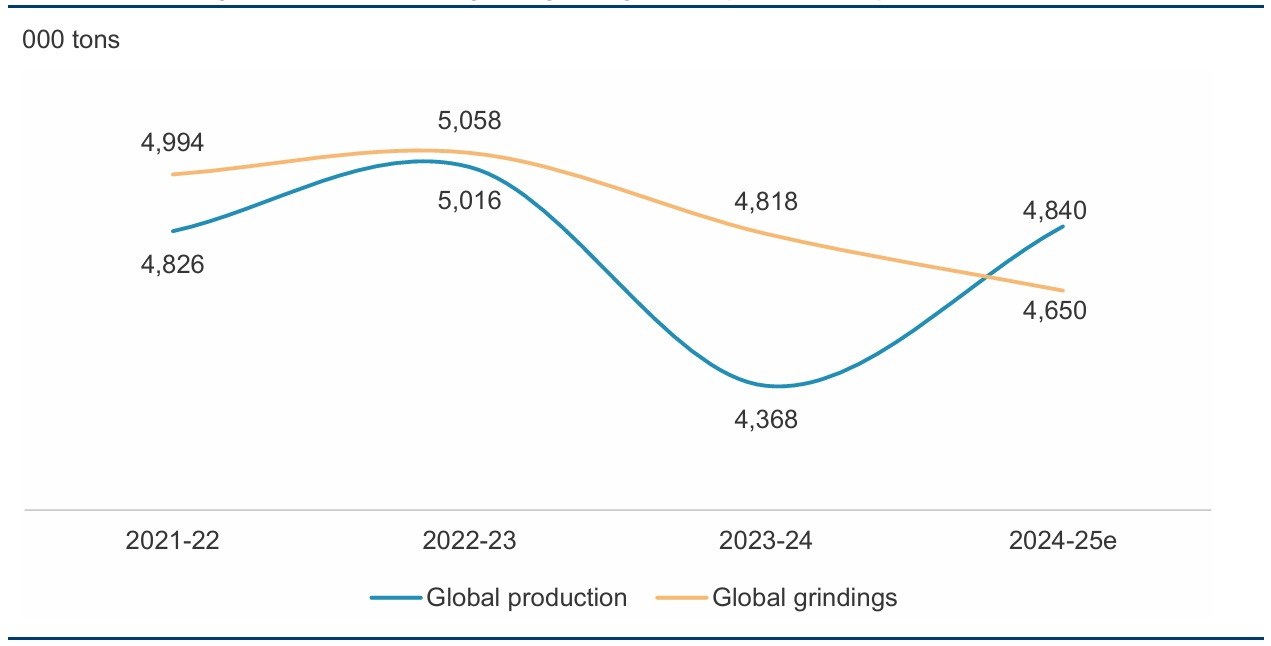Cocoa Market Outlook 2025 – Supply & Pricing Trends
Published on 30 Oct, 2025

Cocoa prices soared to record highs in 2024, disrupting supply chains and squeezing processors’ margins, with grindings estimated to decline for a second consecutive year. Supply signals, however, are turning positive with better crop conditions, supportive policy actions, and rising output from Ecuador. Cocoa futures have since corrected sharply, but demand recovery remains weak as chocolate makers hold prices to protect margins. The market is in transition, and the next turning point will hinge on when retail prices begin to ease and re-ignite consumption.
Cocoa Market at Crossroads: Supply Eases but Pricing Power Persists
The global cocoa market, measured by the annual value of beans produced, is currently estimated at around USD22-24bn. Production is concentrated primarily in West Africa led by Côte d’Ivoire, Ghana, Nigeria, and Cameroon. Outside Africa, Ecuador is the largest cocoa producer and an increasingly important contributor to global supply.
Exhibit 1: West Africa continues to dominate global cocoa production

Source: International Cocoa Organization (ICCO), % are based on ICCO estimates for 2024-25e crop year (Oct-Sep)
Between 2017 and mid-2023, cocoa prices traded within a stable range of USD2,000–3,000 per ton, allowing producers, grinders, and buyers to operate with predictable cost structures. However, in late 2023, the market broke sharply out of this range, with prices surging to nearly USD12,000 per ton in December 2024, driven by:
- Poor harvests and unfavourable weather conditions
- Aging trees and widespread disease outbreaks
- Logistical disruptions across key West African origins
Cocoa bean processors were forced to procure raw material at these inflated levels, sharply increasing their input costs. While part of this spike was passed on to consumers through higher retail chocolate prices, the increase was not absorbed smoothly, leading to a decline in volumes, inventory built up at the retail end, and a sharp reduction in factory orders.
Demand softness: Grinding cuts across regions
This demand pullback quickly showed up in processing data, as cocoa grindings (a key gauge of industrial demand) began to fall through 2024 across major consuming regions. With retailers holding elevated inventories, order cycles were lengthened, forcing processors to curb bean intake. Accordingly, global grindings fell from 5.06mn tons in 2022-23 to 4.82mn tons in 2023-24 and are forecasted to decline further to around 4.65mn tons in 2024-25e, marking a second year of contraction.
Exhibit 2: Following the decline in 2024, global grindings are expected to drop further

Source: ICCO, Years shown reflect harvest year (Oct-Sep), 2024-25e numbers are ICCO’s estimations
Supply signals turn positive, driving price correction
Cocoa supply signals are improving even as grindings tend to be lower. Field reports from major buyers indicate better crop conditions across West Africa, with Mondelez, a key chocolate manufacturer, noting pod counts (a key indicator of upcoming bean availability) are now above ~7% above the five-year average. In Côte d’Ivoire, favorable Q3 2025 rainfall has boosted bean quality, and output is expected to rebound ~10% yoy in 2024-25e after last season’s sharp drop.
Policy support is also visible with governments increasing farmgate prices to encourage deliveries:
- Côte d’Ivoire: Set a record 2,800 CFA/kg (~USD5.0/kg) for 2025–26 season.
- Ghana: Lifted prices to 58,000 cedis/ton (~USD4.64/kg) effective October 2025.
Outside Africa, Ecuador is emerging as a key growth driver, with yields of ~800 kg/hectare well above West Africa’s average of ~500 kg/hectare. Output is expected to exceed 570,000 tons in 2025–26 season and 650,000 tons by 2026–27, positioning the country to surpass Ghana as the world’s second-largest producer.
Reflecting these improving supply signals and policy initiatives, cocoa futures have corrected sharply from their 2024 peak of USD12,000 to around USD5,800 per ton.
Exhibit 3: Prices* ease as supply outlook improves but remain elevated vs pre-crisis levels

Source: ICCO, * indicates daily average of nearest three active ICE (London & New York) cocoa futures contracts
Despite easing cocoa prices, declining grindings signal weak demand. Retail prices remain elevated, with consumers still cautious. We believe the adjustment is now less about raw material costs and more about company-level pricing strategies, as major chocolate makers prioritize margin protection over volume recovery, maintaining high prices instead of stimulating demand.
How Chocolate Manufacturers Are Responding
Leading chocolate makers have acknowledged improving supply conditions and expressed confidence that cocoa availability will normalize in 2025-26e. Yet none of them are signalling broad-based price reductions. Instead, the tone remains consistent: prioritize stability and maintain a cautious approach until conditions become more favourable for renewed growth. Below is how key chocolate players are signalling their 2025 stance across supply, pricing, and demand expectations:
Exhibit 4 - Chocolate majors signal supply relief but hold prices, delaying demand recovery
| Company | View on Cocoa Supply | Pricing Strategy | Demand / Growth Stance |
|---|---|---|---|
| Hershey | Expects global cocoa surplus with improved production in West Africa | Hold price levels and focus on margin rebuilding rather than price discounts | Expects 2025 sales growth to be price-led, not volume-led |
| Mondelez | Sees further easing in prices as cocoa supply improves | Maintain disciplined pricing; no signals of price cuts yet | Revenue expected to be sustained via pricing, with volume recovery lagging |
| Lindt | Better crop outlook and new plantings in Latin America to support supply | No major price reductions planned; monitoring market before adjusting. | Expects global chocolate volumes to decline further in H2 2025 |
| Barry Callebaut | Expects some supply normalization | Focusing on profitability, not chasing volumes | Guiding ~7% volume decline in 2025 |
Across the board, corporate commentary confirms a “cautious stance towards holding prices rather than chasing volume recovery”.
Aranca view: The market is clearly in a transition phase rather than in a recovery. We believe the next turning point will not be driven by changes in cocoa futures prices alone but depend largely on when retail chocolate prices begin to adjust lower meaningfully. Whether this adjustment begins in late 2025 or is deferred to 2026 will depend on competitive behaviour within the industry. For now, pricing discipline remains intact, but early signals, such as a rise in promotional activity or reversal of recent pack-size reductions, will indicate when companies move from margin restoration to volume reactivation.
For portfolio managers, we believe the real opportunity lies in identifying which strategy begins to outperform first. Companies that hold price may outperform if demand takes longer to recover, while those that lead with select discounting could capture share early once consumers respond to price relief. Monitoring this divergence will be key to spotting relative winners ahead of the demand turn.

